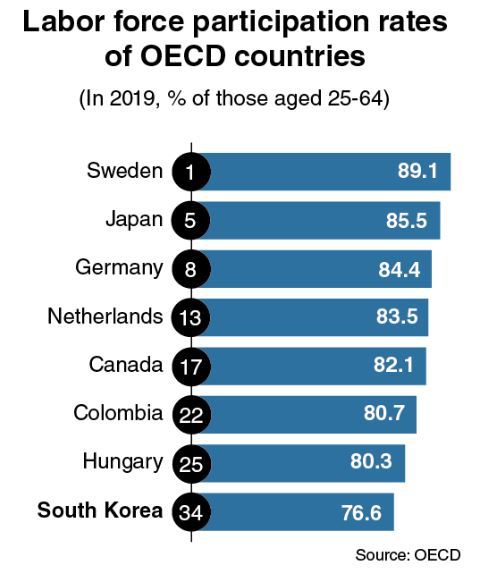SEJONG — South Korea’s labor force participation rate was the 34th-highest among the 37 members of the Organization for Economic Cooperation and Development as of 2019.
In the Paris-based organization’s comparison of labor participation rates for those aged 25-64, Korea posted 76.6 percent. This means about 1 in 4 Koreans in that age bracket were not engaging in economic activities last year.
This contrasts with an 85.5 percent labor force participation rate in neighboring Japan, which stood fifth from the top, and 80.7 percent in Colombia, which became an OECD member this year and stood at No. 22.
Sweden topped the list with an 89.1 percent labor force participation rate, followed by Iceland with 88.9 percent, Switzerland with 87.7 percent and Lithuania with 85.7 percent.
Among the English-speaking countries, New Zealand ranked sixth with 85.3 percent, the UK 16th (82.3 percent), Canada 17th (82.1 percent), Australia 20th (81 percent) and the US 29th (78.2 percent).
(Graphic by Kim Sun-young/The Korea Herald)
(Graphic by Kim Sun-young/The Korea Herald)
While the OECD average was 78.4 percent, members with figures above the average included France (79.7 percent), Slovakia (80.4 percent), Spain (81 percent), Slovenia (81.8 percent), Norway (83.5 percent), Denmark (83.4 percent), Portugal (83.7 percent) and Germany (84.4 percent).
The average was 80.3 percent both for the Group of Seven countries and for the 27-member European Union plus the UK. Other countries with figures higher than Korea’s included Greece, Poland, Belgium and Chile.
Further, some non-OECD countries posted higher labor force participation rates than Korea. They included Indonesia, Namibia, Costa Rica, Malta, Russia, Bulgaria and Cyprus.
The OECD also compared figures for those aged 15-24. The labor participation rate for this age bracket in Korea was 29.6 percent, placing the country at No. 35 of the 37 OECD members.
While the OECD average was 48.1 percent, Iceland’s labor participation rate was the highest at 78.2 percent. The Netherlands ranked second with 70 percent, trailed by Australia with 68.1 percent and Switzerland with 66.5 percent.
Among the countries with higher-than-average figures for young people’s participation in the labor force were Japan, Colombia, Germany, Sweden, the US, the UK and Canada.
Some nonmembers also outstripped the OECD average. Labor force participation rates came to 48.3 percent in Indonesia, 52.7 percent in Namibia, 56 percent in Malta and 57 percent in Brazil.
In contrast, for those aged 65 or over Korea ranked second with 34 percent last year. The OECD average was just 16 percent.
Korea has a relatively high proportion of self-employed businesspeople, for whom there is no set retirement age, and seniors outside the capital engaged in agriculture or fishing.
In addition, since late 2017 the incumbent administration has actively increased the number of nonregular jobs for seniors in public agencies, which may have increased its ranking.
In terms of labor force participation among seniors, Iceland was at the top of the list with 35.2 percent. Japan was sixth with 25.3 percent.
Many of the countries that ranked highly in the comparison of working-age populations (15-64) posted lower rates of labor participation among seniors. They included Switzerland at 11.3 percent, Norway at 11 percent, the Netherlands at 9.4 percent, Germany at 7.8 percent and Spain at 2.5 percent.
“This could be attributable to a high portion of people enjoying post-retirement life involving leisure activities in Western countries,” said a local job market analyst.
By Kim Yon-se ([email protected])


